Region: 新疆Xinjiang
高昌故城图片Gaochang Ruins Pictures
-
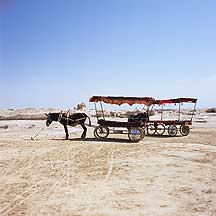
Tourist donkey carts are readily available. You can hop on for a ride to the palace or anywhere you like. The wheels of these carts are especially equipped with spikes, so they are quick and efficient on the ruins's rough mud road.
-

-

-

-
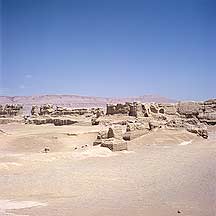
The ruins with the 火焰山 Huoyan Shan (Flaming Mountains) in the background.
-

The ruins with the 火焰山 Huoyan Shan (Flaming Mountains) in the background.
-

-

The ruins with the 火焰山 Huoyan Shan (Flaming Mountains) in the background.
-

-

-

The donkey carts rushing through what used to be the main roads through the old capital city. In the background of the ruins is the 火焰山 Huoyan Shan (Flaming Mountains) Huoyan Shan (Flaming Mountains) in the background.
-

Some of the ruins are still quite high, But nothing blocks the unique 火焰山 Huoyan Shan (Flaming Mountains) lying in the background.
-

In the background of the ruins is the 火焰山 Huoyan Shan (Flaming Mountains) in the background.
-

In the background of the ruins is the 火焰山 Huoyan Shan (Flaming Mountains) in the background.
-

-

-

Inside cave-like ruins.
-

-
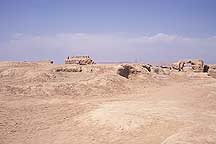
-

This building is reconstructed in the 1980's, but I was unable to confirm its identity. Some said it is a General's Headquarter, but that seems too small. It is more likely a reconstruction of a buddhist meditation chamber - more fitting and more important in this once highly regarded buddhist center.
-

-
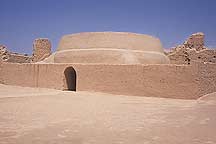
This structure is reconstructed in the 1980's, but I was unable to confirm its identity. Some said it is a General's Headquarter, but that seems too small. It is more likely a reconstruction of a Buddhist meditation chamber - more fitting and more important in this once highly regarded Buddhist center.
-

-

Three local beauties to keep the tourists busy.
-

The surviving remains of the palace area. A large temple was also in the area.
-
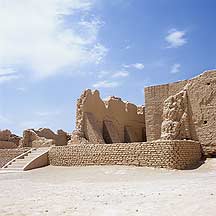
The surviving remains of the palace area.
-

The remaining walls of the palace complex.
-

The surviving remains of the palace area.
-

The remaining walls of the palace complex.
-

Tourists exploring the palace complex.
-

The thick city wall. Although parts of the wall had crumbled, it's remain size is still impressive.
-

A camel tied to the outter city wall.
- 1A dynastic chart of the four kingdoms can be found at 维基百科 the Chinese site of Wikipedia, in the article on 高昌Gaochang.
- 2.The city layout data are derived from 百度百科Baidu Baike's article of the same subject.

















